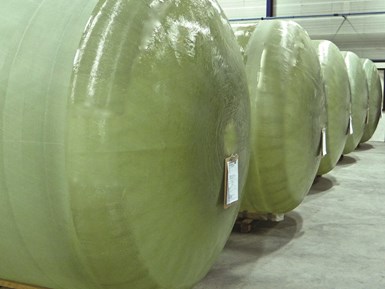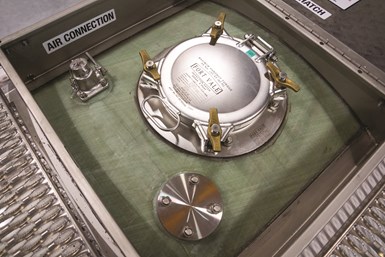Composite tanks best stainless steel over road, rail and sea
One-piece, filament wound containers cost less, hold more, last longer.

Den Hartogh Logistics’ (Rotterdam, Netherlands) fleet of more than 19,000 tank containers now includes composite tanks manufactured by Tankwell (Wieringerwerf, Netherlands). Source | Aliancys
Given increasing competition in the European road and intermodal transport market, transportation carriers across the region are seeking opportunities to increase payload and/or reduce freight cost. In search of a lighter, less maintenance-intensive tank container with a 15- to 20-year service life, Den Hartogh Logistics (Rotterdam, Netherlands), which fields a chemical transport fleet fitted with more than 19,000 stainless steel tank containers worldwide, managed to connect with a relatively new Dutch company, Tankwell (Wieringerwerf, The Netherlands), a spinoff brand of Wieringerwerf-based Composite Production Technology.

Tankwell containers are made in one filament winding operation, instead of the conventional method, which mates separate end- caps with a filament wound cylinder. Source | Aliancys
Tankwell introduced, in 2015, a novel technology for manufacturing large composite tanks, explains Casper Willems, managing director: “The entire tank is made in one filament winding operation, instead of the traditional method of mating separate end-caps with a filament wound cylinder. This means the wall thickness of the composite tank is lower than for comparable composite tank structures.”
Willems adds that an external frame is incorporated in the overall design, resulting in an assembly with excellent rigidity and mechanical integrity. Access manholes, valves and auxiliary components are still standard metallic parts, integrated into the composite structure. Tankwell manufactures the large bulk tanks, using trademarked Atlac 5200 FC vinyl ester resin from Aliancys AG (formerly DSM Composite Resins, Schaffhausen, Switzerland, now AOC Aliancys), delivered by distributor Euroresins (Budel, Netherlands).
The high-strength vinyl ester can be tailored to resist a broad range of chemicals. Rob van de Laarschot, head of technical service at Aliancys, says, “In order to fit tanks for specific chemicals, we can build on our chemical resistance information system, based on years of resin chemical resistance testing.”

An external frame is incorporated in the tank’s overall design for rigidity and mechanical integrity. Access manholes, valves and auxiliary components, shown here, are standard metallic parts, integrated into the composite structure. Source | Aliancys
The composite tank container has received all relevant approvals for carrying chemicals, after extensive material and product testing under third-party oversight, including fire-safety and mechanical-impact testing.
Den Hartogh Logistics began using the composite tank containers in its fleet in December 2015, and the results reportedly have been impressive: The 31,000-liter composite “swap body” tank container (transportable either by truck, rail car or ship) weighs 2,200 kilograms, 40% less than a traditional stainless steel tank. Nevertheless it holds 2 MT more product, says Jacco van Holten, commercial director at Den Hartogh Logistics.
The overall result is a 5-10% reduction in freight cost per shipment. Further, the composite tank’s inner surface is smoother and resists chemical corrosion and pitting, and therefore requires less scrubbing and rinsing during product changeover.
Related Content
-
Materials & Processes: Composites fibers and resins
Compared to legacy materials like steel, aluminum, iron and titanium, composites are still coming of age, and only just now are being better understood by design and manufacturing engineers. However, composites’ physical properties — combined with unbeatable light weight — make them undeniably attractive.
-
Composite rebar for future infrastructure
GFRP eliminates risk of corrosion and increases durability fourfold for reinforced concrete that meets future demands as traffic, urbanization and extreme weather increase.
-
The state of recycled carbon fiber
As the need for carbon fiber rises, can recycling fill the gap?
















